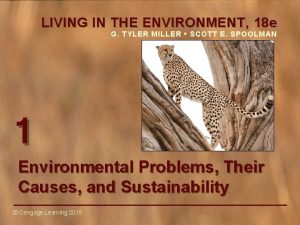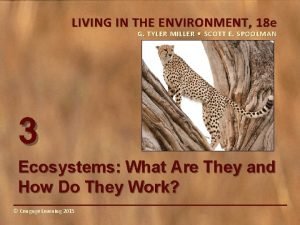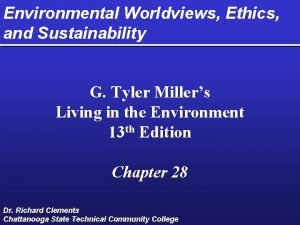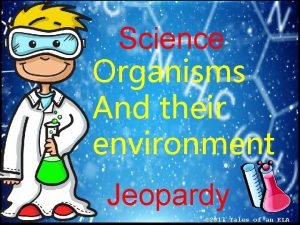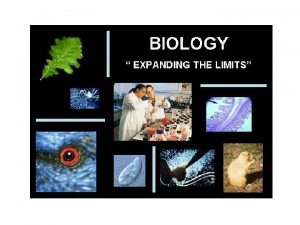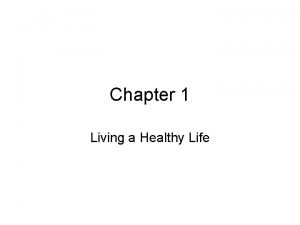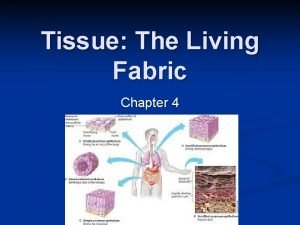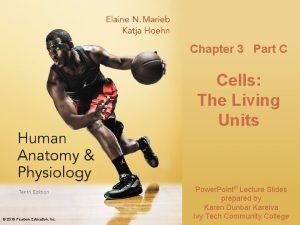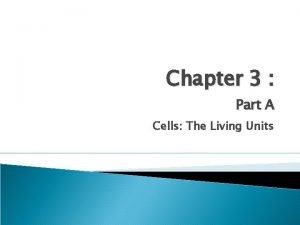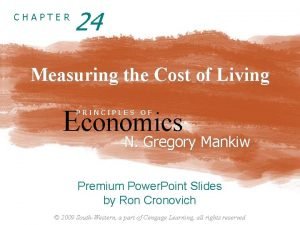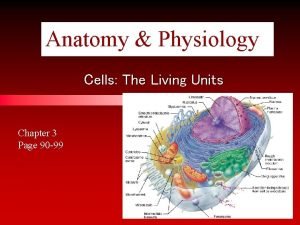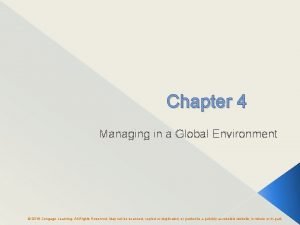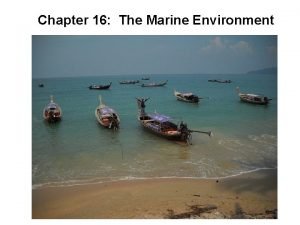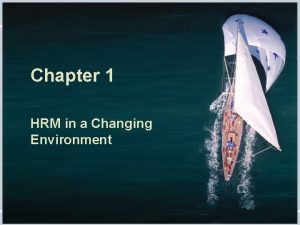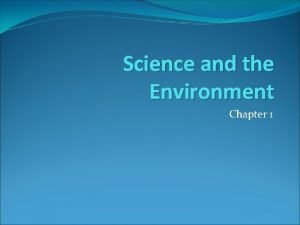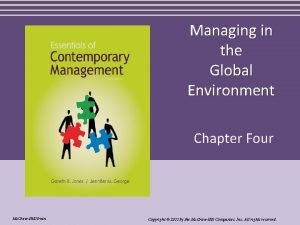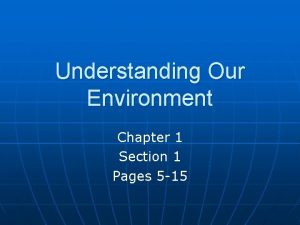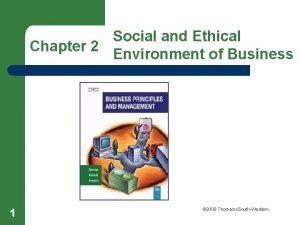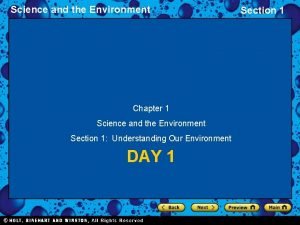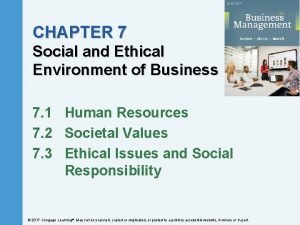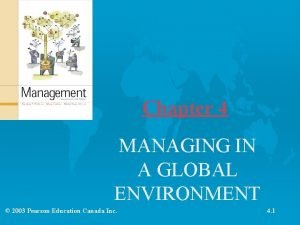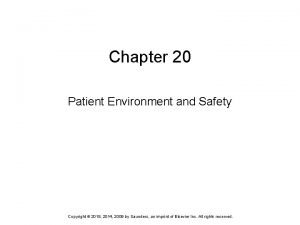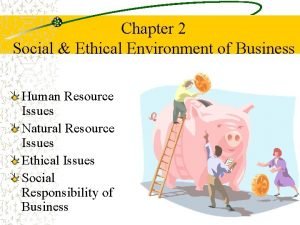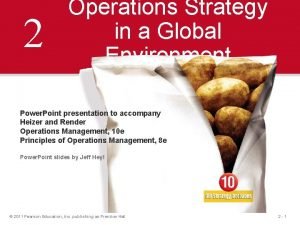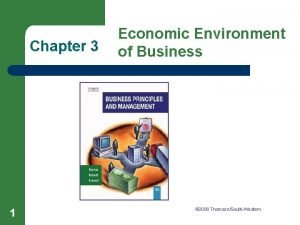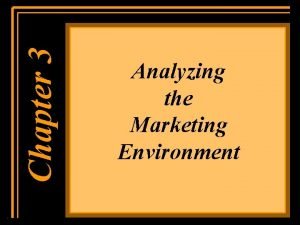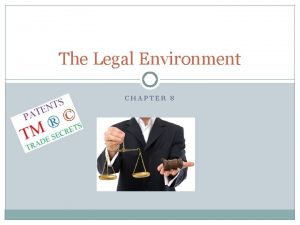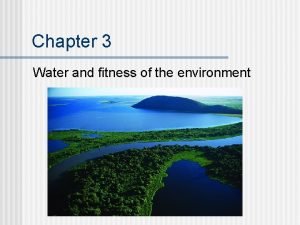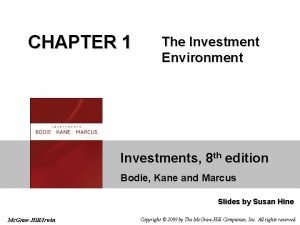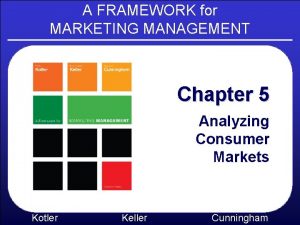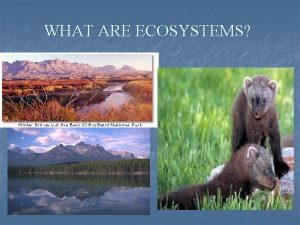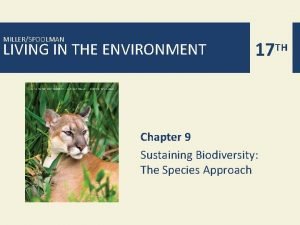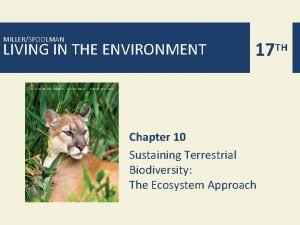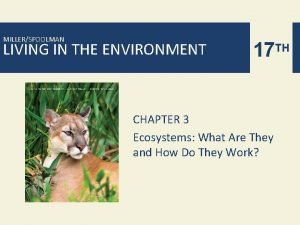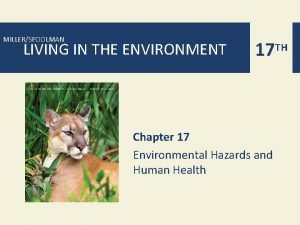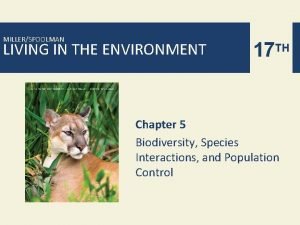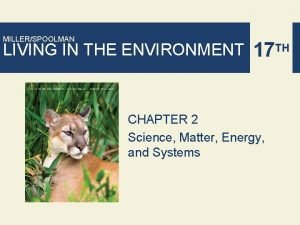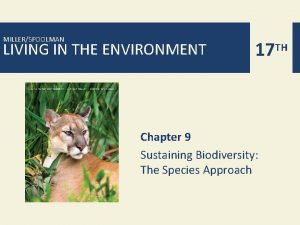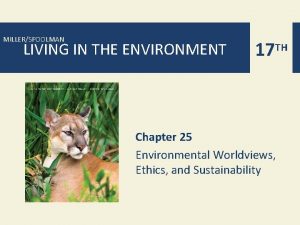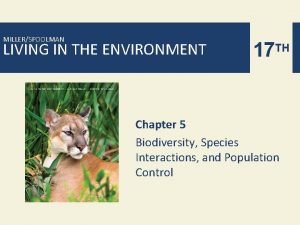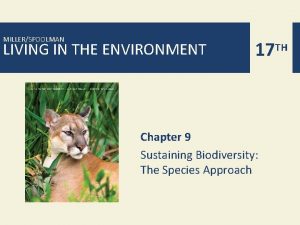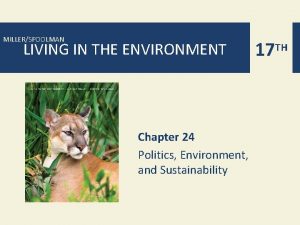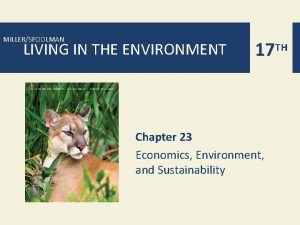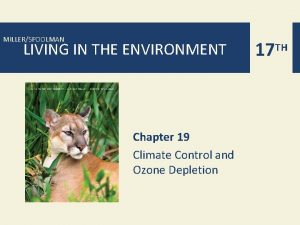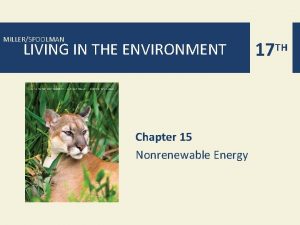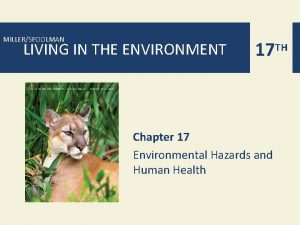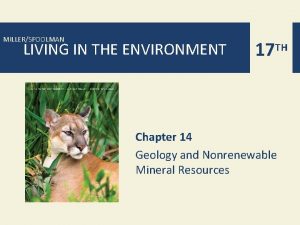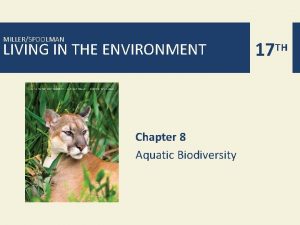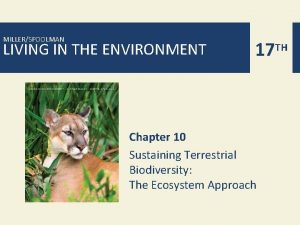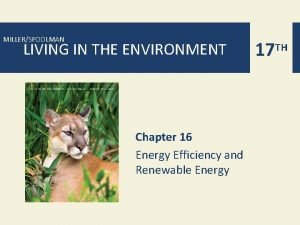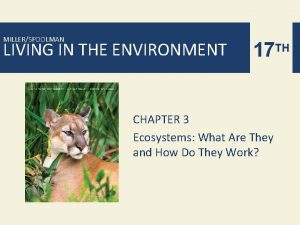MILLERSPOOLMAN LIVING IN THE ENVIRONMENT 17 TH Chapter



























































































- Slides: 91

MILLER/SPOOLMAN LIVING IN THE ENVIRONMENT 17 TH Chapter 21 Solid and Hazardous Waste

Core Case Study: E-waste—An Exploding Problem (1) § Electronic waste, e-waste: fastest growing solid waste problem § Most ends up in landfills and incinerators § Composition includes • High-quality plastics • Valuable metals • Toxic and hazardous pollutants

Core Case Study: E-waste—An Exploding Problem (2) § Shipped to other countries • What happens in China and India? § International Basel Convention • Bans transferring hazardous wastes from developed countries to developing countries § European Union • Cradle-to-grave approach

Core Case Study: E-waste—An Exploding Problem (3) § What should be done? • • Recycle E-cycle Reuse Prevention approach: remove the toxic materials

Rapidly Growing E-Waste from Discarded Computers and Other Electronics Fig. 21 -1, p. 557

21 -1 What Are Solid Waste and Hazardous Waste, and Why Are They Problems? § Concept 21 -1 Solid waste contributes to pollution and represents the unnecessary consumption of resources; hazardous waste contributes to pollution as well as to natural capital degradation, health problems, and premature deaths.

We Throw Away Huge Amounts of Useful Things and Hazardous Materials (1) § Solid waste • Industrial solid waste • Mines, farms, industries • Municipal solid waste (MSW) • Trash • Hazardous waste (toxic waste) • • Threatens human health of the environment Organic compounds Toxic heavy metals Radioactive waste

We Throw Away Huge Amounts of Useful Things and Hazardous Materials (2) § 80– 90% of hazardous wastes produced by developed countries • U. S. is the largest producer § Why reduce solid wastes? 1. ¾ of the materials are an unnecessary waste of the earth's resources 2. Huge amounts of air pollution, greenhouse gases, and water pollution

What Harmful Chemicals Are in Your Home? Fig. 21 -2, p. 559

What Harmful Chemicals Are in Your Home? Cleaning Gardening Disinfectants Pesticides Drain, toilet, and window cleaners Weed killers Spot removers Septic tank cleaners Ant and rodent killers Flea powders Paint Products Paints, stains, varnishes, and lacquers Paint thinners, solvents, and strippers Wood preservatives Artist paints and inks Automotive Gasoline Used motor oil General Dry-cell batteries (mercury and cadmium) Glues and cements Antifreeze Battery acid Brake and transmission fluid Fig. 21 -2, p. 559

What Harmful Chemicals Are in Your Home? Cleaning Disinfectants Drain, toilet, and window cleaners Spot removers Septic tank cleaners Paint Products Paints, stains, varnishes, and lacquers Paint thinners, solvents, and strippers Wood preservatives Artist paints and inks General Dry-cell batteries (mercury and cadmium) Glues and cements Gardening Pesticides Weed killers Ant and rodent killers Flea powders Automotive Gasoline Used motor oil Antifreeze Battery acid Brake and transmission fluid Stepped Art Fig. 21 -2, p. 559

Natural Capital Degradation: Solid Wastes Polluting a River in Indonesia Fig. 21 -3, p. 560

Solid Waste in the United States § Leader in solid waste problem • What is thrown away? § Leader in trash production, by weight, person § Recycling is helping

Total and Per Capita Production of Municipal Solid Waste in the U. S. Fig. 21 -4, p. 560

2. 5 250 Per capita 200 2. 0 150 1. 5 100 Per capita generation (kilograms/person/day) Total municipal solid waste (million tons per year) Total 1. 0 50 1970 1990 2003 2005 2007 2009 Year Fig. 21 -4, p. 560

Hundreds of Millions of Discarded Tires in a Dump in Colorado Fig. 21 -5, p. 561

21 -2 How Should We Deal with Solid Waste? § Concept 21 -2 A sustainable approach to solid waste is first to reduce it, then to reuse or recycle it, and finally to safely dispose of what is left.

We Can Burn or Bury Solid Waste or Produce Less of It § Waste Management • Reduce harm, but not amounts § Waste Reduction • Use less and focus on reuse, recycle, compost § Integrated waste management • Uses a variety of strategies

Integrated Waste Management Fig. 21 -6, p. 562

Raw materials Processing and manufacturing Products Solid and hazardous wastes generated during the manufacturing process Waste generated by households and businesses Plastic Glass Metal Paper To manufacturers for reuse or for recycling Food/yard waste Hazardous waste Compost Hazardous waste management Remaining mixed waste Landfill Incinerator Fertilizer Fig. 21 -6, p. 562

Integrated Waste Management: Priorities for Dealing with Solid Waste Fig. 21 -7, p. 562

First Priority Primary Pollution and Waste Prevention Change industrial process to eliminate use of harmful chemicals Use less of a harmful product Reduce packaging and materials in products Make products that last longer and are recyclable, reusable, or easy to repair Second Priority Secondary Pollution and Waste Prevention Reuse Repair Recycle Compost Buy reusable and recyclable products Last Priority Waste Management Treat waste to reduce toxicity Incinerate waste Bury waste in landfills Release waste into environment for dispersal or dilution Fig. 21 -7, p. 562

First Priority Second Priority Last Priority Primary Pollution and Waste Prevention Second Pollution and Waste Prevention Waste Management §Change industrial process to eliminate use of harmful chemicals §Reuse §Treat waste to reduce toxicity §Repair §Use less of a harmful product §Incinerate waste §Recycle §Reduce packaging and materials in products §Make products that last longer and are recyclable, reusable, or easy to repair §Bury waste in landfills §Compost §Buy reusable and recyclable products §Release waste into environment for dispersal or dilution Stepped Art Fig. 21 -7, p. 562

Science Focus: Garbology § William Rathje: analyzes garbage in landfills § Landfills and trash decomposition • Much slower than previously thought

We Can Cut Solid Wastes by Reducing, Reusing, and Recycling (1) § Waste reduction is based on • Reduce • Reuse • Recycle

We Can Cut Solid Wastes by Reducing, Reusing, and Recycling (2) § Six strategies: 1. Redesign manufacturing processes and products to use less material and energy 2. Develop products that are easy to repair, reuse, remanufacture, compost, or recycle 3. Eliminate or reduce unnecessary packaging 4. Use fee-per-bag waste collection systems 5. Establish cradle-to grave responsibility 6. Restructure urban transportation systems

What Can You Do? Solid Waste Fig. 21 -8, p. 563

21 -3 Why Are Reusing and Recycling Materials So Important? § Concept 21 -3 Reusing items decreases the consumption of matter and energy resources, and reduces pollution and natural capital degradation; recycling does so to a lesser degree.

Reuse: Important Way to Reduce Solid Waste, Pollution, and Save Money § Reuse: clean and use materials over and over § Downside of reuse in developing countries • Salvaging poor exposed to toxins § Flea markets, yard sales, second-hand stores, e. Bay, Craigslist, freecycle. org § Rechargeable batteries

Case Study: Use of Refillable Containers § Reuse and recycle • Refillable glass beverage bottles • Refillable soft drink bottles made of polyethylene terephthalate (PET) plastic • Bottle deposits create jobs and reduce litter and landfill amounts § Paper, plastic, or reusable cloth bags • Pros • Cons

What Can You Do? Reuse Fig. 21 -9, p. 565

There Are Two Types of Recycling (1) § Primary, closed-loop recycling • Materials recycled into same type: aluminum cans § Secondary recycling • Materials converted to other products: tires § Types of wastes that can be recycled • Preconsumer: internal waste • Postconsumer: external waste

There Are Two Types of Recycling (2) § Do items actually get recycled? § What are the numbers?

We Can Mix or Separate Household Solid Wastes for Recycling (1) § Materials-recovery facilities (MRFs) • Can encourage increased trash production § Source separation • Pay-as-you-throw • Fee-per-bag § Which program is more cost effective? § Which is friendlier to the environment?

We Can Mix or Separate Household Solid Wastes for Recycling (2) § Composting • Individual • Municipal § Benefits § San Francisco, 2009 § Edmonton, Alberta, Canada

Backyard Composter Drum: Bacteria Convert Kitchen Waste into Compost Fig. 21 -10, p. 566

Case Study: Recycling Paper § Production of paper versus recycled paper • Energy use: world’s fifth largest consumer • Water use • Pollution § Countries that lead recycling efforts § Replacement of chlorine-based bleaching chemicals with H 2 O 2 or O 2

Case Study: Recycling Plastics § Plastics: composed of resins created from oil and natural gas § Most containers discarded: 4% recycled § Litter: beaches, oceans • Kills wildlife • Gets into food chain and seafood

Discarded Solid Waste Litters Beaches Fig. 21 -11, p. 568

Individuals Matter: Mike Biddle’s Contribution to Recycling Plastics § Mike Biddle and Trip Allen: MBA Polymers, Inc. § Leaders in plastic recycling § Plants in • U. S. • China • Australia

Science Focus: Bioplastics (1) § Plastics from soybeans: not a new concept § Key to bioplastics: catalysts that speed reactions § Sources • Corn • Soy • Sugarcane

Science Focus: Bioplastics (2) § Sources cont… • • Switchgrass Chicken feathers Some garbage CO 2 from coal-burning plant emissions § Benefits: lighter, stronger, cheaper, and biodegradable

Recycling Has Advantages and Disadvantages § Advantages § Disadvantages

Trade-Offs: Recycling Fig. 21 -12, p. 569

Trade-Offs Recycling Advantages Disadvantages Reduces energy and mineral use and air and water pollution Can cost more than burying in areas with ample landfill space Reduces greenhouse gas emissions Reduces profits for landfill and incinerator owners Reduces solid waste Can save landfill space Source separation inconvenient for some Fig. 21 -12, p. 569

We Can Encourage Reuse and Recycling (1) § What hinders reuse and recycling? 1. Market prices don’t include harmful costs associated with production, use, discarding 2. Recycling industries get less favorable government treatment than large industries do 3. Prices for recycled materials fluctuate

We Can Encourage Reuse and Recycling (2) § Encourage reuse and recycling • Government • Increase subsidies and tax breaks for using such products • Decrease subsidies and tax breaks for making items from virgin resources • Fee-per-bag collection • New laws • Citizen pressure

21 -4 The Advantages and Disadvantages of Burning or Burying Solid Waste § Concept 21 -4 Technologies for burning and burying solid wastes are well developed, but burning contributes to air and water pollution and greenhouse gas emissions, and buried wastes eventually contribute to the pollution and degradation of land water resources.

Burning Solid Waste Has Advantages and Disadvantages § Waste-to-energy incinerators § 600 globally • Most in Great Britain § Advantages § Disadvantages

Solutions: A Waste-to-Energy Incinerator with Pollution Controls Fig. 21 -13, p. 571

Electricity Steam Crane Smokestack Turbine Generator Wet scrubber Furnace Boiler Electrostatic precipitator Waste pit Water added Bottom. Dirty water Conveyor ash Fly ash To waste treatment plant Ash for treatment, disposal in landfill, or use as landfill cover Fig. 21 -13, p. 571

Trade-Offs: Waste-to-Energy Incineration Fig. 21 -14, p. 571

Trade-Offs Waste-to-Energy Incineration Advantages Disadvantages Reduces trash volume Expensive to build Produces energy Produces a hazardous waste Concentrates hazardous substances into ash for burial Emits some CO 2 and other air pollutants Sale of energy reduces cost Encourages waste production Fig. 21 -14, p. 571

Burying Solid Waste Has Advantages and Disadvantages § Open dumps • Widely used in less-developed countries • Rare in developed countries § Sanitary landfills

Solutions: State-of-the-Art Sanitary Landfill Fig. 21 -15, p. 572

Topsoil Sand Clay Garbage Probes to detect methane leaks When landfill is full, layers of soil and clay seal in trash Methane storage and compressor building Methane gas recovery well Electricity generator building Leachate treatment system Pipes collect explosive methane for use as fuel to generate Leachate electricity storage tank Compacted solid waste Garbage Sand Synthetic liner Sand Clay Subsoil Leachate pipes Leachate pumped up to storage tank for safe disposal Groundwater Clay and plastic lining to prevent leaks; pipes collect leachate from bottom of landfill Groundwater monitoring well Leachate monitoring well Fig. 21 -15, p. 572

Trade-Offs: Sanitary Landfills Fig. 21 -16, p. 572

Trade-Offs Sanitary Landfills Advantages Disadvantages Low operating costs Noise, traffic, and dust Can handle large amounts of waste Releases greenhouse gases (methane and CO 2) unless they are collected Filled land can be used for other purposes Output approach that encourages waste production No shortage of landfill space in many areas Eventually leaks and can contaminate groundwater Fig. 21 -16, p. 572

21 -5 How Should We Deal with Hazardous Waste? § Concept 21 -5 A sustainable approach to hazardous waste is first to produce less of it, then to reuse or recycle it, then to convert it to less hazardous materials, and finally, to safely store what is left.

We Can Use Integrated Management of Hazardous Waste § Integrated management of hazardous wastes • Produce less • Convert to less hazardous substances • Rest in long-term safe storage § Increased use for postconsumer hazardous waste

Integrated Hazardous Waste Management Fig. 21 -17, p. 573

Produce Less Hazardous Waste Change industrial processes to reduce or eliminate hazardous waste production Recycle and reuse hazardous waste Convert to Less Hazardous or Nonhazardous Substances Natural decomposition Incineration Thermal treatment Chemical, physical, and biological treatment Dilution in air or water Put in Perpetual Storage Landfill Underground injection wells Surface impoundments Underground salt formations Fig. 21 -17, p. 573

Produce Less Hazardous Waste Convert to Less Hazardous or Nonhazardous Substances Put in Perpetual Storage §Change industrial processes to reduce or eliminate hazardous waste production §Natural decomposition §Landfill §Incineration §Underground injection wells §Recycle and reuse hazardous waste §Thermal treatment §Surface impoundments §Chemical, physical, and biological treatment §Underground salt formations §Dilution in air or water Stepped Art Fig. 21 -17, p. 573

Case Study: Recycling E-Waste § 70% goes to China • Hazardous working conditions • Includes child workers § Reduce toxic components in electronics § Dell and HP take recycle their products § Europe has high-tech smelters with strict standards

We Can Detoxify Hazardous Wastes § Collect and then detoxify • • • Physical methods Chemical methods Use nanomagnets Bioremediation Phytoremediation § Incineration § Using a plasma arc torch

Solutions: Phytoremediation Fig. 21 -18, p. 575

Radioactive contaminants Sunflower Landfill Polluted groundwate Soil r in Groundwater Rhizofiltration Roots of plants such as sunflowers with dangling roots on ponds or in greenhouses can absorb pollutants such as radioactive strontium-90 and cesium-137 and various organic chemicals. Inorganic metal contaminants Indian mustard Brake fern Organic contaminants Poplar tree Willow tree Decontaminated water out Phytostabilization Plants such as willow trees and poplars can absorb chemicals and keep them from reaching groundwater or nearby surface water. Oil spill Polluted leachate Phytodegredation Plants such as poplars can absorb toxic organic chemicals and break them down into less harmful compoinds which they store or release slowly into the air. Soil Groundwater Phytoextraction Roots of plants such as Indian mustard and brake ferns can absorb toxic metals such as lead, arsenic, and others and store them in their leaves. Plants can then be recycled or harvested and incinerated. Fig. 21 -18, p. 575

Trade-Offs: Plasma Arc Fig. 21 -19, p. 576

Trade-Offs Plasma Arc Advantages Disadvantages Small High cost Produces CO 2 and CO Mobile. Easy to move to different sites Produces no toxic ash Can release particulates and chlorine gas Can vaporize and release toxic metals and radioactive elements Fig. 21 -19, p. 576

We Can Store Some Forms of Hazardous Waste (1) § Burial on land or long-term storage • Last resort only § Deep-well disposal • 64% of hazardous liquid wastes in the U. S.

Trade-Offs: Deep-Well Disposal Fig. 21 -20, p. 576

Trade-Offs Deep-Well Disposal Advantages Disadvantages Safe if sites are chosen carefully Leaks from corrosion of well casing Wastes can often be retrieved Low cost Emits CO 2 and other air pollutants Output approach that encourages waste production Fig. 21 -20, p. 576

We Can Store Some Forms of Hazardous Waste (2) § Surface impoundments • Lined ponds or pits § Secure hazardous landfills

Surface Impoundment in Niagara Falls, New York Fig. 21 -21, p. 577

Trade-Offs Surface Impoundments Fig. 21 -22, p. 577

Trade-Offs Surface Impoundments Advantages Disadvantages Low cost Groundwater contamination from leaking liners (and overflow from flooding) Wastes can often be retrieved Air pollution from volatile organic compounds Can store wastes indefinitely with secure double liners Output approach that encourages waste production Fig. 21 -22, p. 577

Solutions: Secure Hazardous Waste Landfill Fig. 21 -23, p. 577

Bulk waste Gas Topsoil vent Earth Impervious clay Plastic cover Sand Impervious clay. Clay cap Water table Earth Groundwater Double leachate collection system Leak detection system Plastic Reactive double linerwastes in drums Groundwater monitoring well Fig. 21 -23, p. 577

What Can You Do? Hazardous Waste Fig. 21 -24, p. 578

Case Study: Hazardous Waste Regulation in the United States (1) § 1976: Resource Conservation and Recovery Act (RCRA) • EPA sets standards and gives permits • Cradle to grave • Covers only 5% of hazardous wastes

Case Study: Hazardous Waste Regulation in the United States (2) § 1980: Comprehensive Environmental, Compensation, and Liability Act (CERCLA) • National Priorities List • 2010: 1300 sites, 340 sites cleaned so far • Pace of cleanup has slowed • Superfund is broke § Laws encouraging the cleanup of brownfields

Leaking Barrels of Toxic Waste at a Superfund Site in the United States Fig. 21 -25, p. 578

21 -6 How Can We Make the Transition to a More Sustainable Low-Waste Society? § Concept 21 -6 Shifting to a low-waste society requires individuals and businesses to reduce resource use and to reuse and recycle wastes at local, national, and global levels.

Grassroots Action Has Led to Better Solid and Hazardous Waste Management § “Not in my backyard” § Produce less waste • “Not in anyone’s backyard” • “Not on planet Earth”

Providing Environmental Justice for Everyone Is an Important Goal § Environmental Justice • Everyone is entitled to protection from environmental hazards § Which communities in the U. S. have the largest share of hazardous waste dumps? § Environmental discrimination

International Treaties Have Reduced Hazardous Waste (1) § Basel Convention • 1992: in effect • 1995 amendment: bans all transfers of hazardous wastes from industrialized countries to lessdeveloped countries • 2009: Ratified by 195 countries, but not the United States

International Treaties Have Reduced Hazardous Waste (2) § 2000: Delegates from 122 countries completed a global treaty • • Control 12 persistent organic pollutants (POPs) “Dirty dozen” DDT, PCBs, dioxins Everyone on earth has POPs in blood § 2000: Swedish Parliament law • By 2020 ban all chemicals that are persistent and can accumulate in living tissue

We Can Make the Transition to Low-Waste Societies § Norway, Austria, and the Netherlands • Committed to reduce resource waste by 75% § East Hampton, NY, U. S. • Reduced solid waste by 85% § Follow guidelines to prevent pollution and reduce waste

Case Study: Industrial Ecosystems: Copying Nature § Biomimicry: using natural principles to solve human problems § Nature: wastes of one organism are nutrients for another; apply to industry • Ecoindustrial parks § Two major steps of biomimicry 1. Observe how natural systems respond 2. Apply to human industrial systems

Three Big Ideas 1. The order of priorities for dealing with solid waste should be to produce less of it, reuse and recycle as much of it as possible, and safely dispose of what is left. 2. The order of priorities for dealing with hazardous waste should be to produce less of it, reuse or recycle it, convert it to less hazardous material, and safely store what is left.

Three Big Ideas 3. We need to view solid wastes as wasted resources and hazardous wastes as materials that we should not be producing in the first place.
 Venn diagram of living and non living things
Venn diagram of living and non living things Is mold living or nonliving
Is mold living or nonliving Living non living dead
Living non living dead Smallest living unit
Smallest living unit Living in the environment
Living in the environment Living in the environment 18th edition
Living in the environment 18th edition Life centered worldview
Life centered worldview Living environment jeopardy
Living environment jeopardy Living environment review packet
Living environment review packet Is living environment biology
Is living environment biology Financial environment of business
Financial environment of business Hát kết hợp bộ gõ cơ thể
Hát kết hợp bộ gõ cơ thể Frameset trong html5
Frameset trong html5 Bổ thể
Bổ thể Tỉ lệ cơ thể trẻ em
Tỉ lệ cơ thể trẻ em Chó sói
Chó sói Thang điểm glasgow
Thang điểm glasgow Chúa yêu trần thế alleluia
Chúa yêu trần thế alleluia Các môn thể thao bắt đầu bằng tiếng đua
Các môn thể thao bắt đầu bằng tiếng đua Thế nào là hệ số cao nhất
Thế nào là hệ số cao nhất Các châu lục và đại dương trên thế giới
Các châu lục và đại dương trên thế giới Cong thức tính động năng
Cong thức tính động năng Trời xanh đây là của chúng ta thể thơ
Trời xanh đây là của chúng ta thể thơ Mật thư anh em như thể tay chân
Mật thư anh em như thể tay chân Làm thế nào để 102-1=99
Làm thế nào để 102-1=99 Phản ứng thế ankan
Phản ứng thế ankan Các châu lục và đại dương trên thế giới
Các châu lục và đại dương trên thế giới Thơ thất ngôn tứ tuyệt đường luật
Thơ thất ngôn tứ tuyệt đường luật Quá trình desamine hóa có thể tạo ra
Quá trình desamine hóa có thể tạo ra Một số thể thơ truyền thống
Một số thể thơ truyền thống Bàn tay mà dây bẩn
Bàn tay mà dây bẩn Vẽ hình chiếu vuông góc của vật thể sau
Vẽ hình chiếu vuông góc của vật thể sau Thế nào là sự mỏi cơ
Thế nào là sự mỏi cơ đặc điểm cơ thể của người tối cổ
đặc điểm cơ thể của người tối cổ V cc cc
V cc cc Vẽ hình chiếu đứng bằng cạnh của vật thể
Vẽ hình chiếu đứng bằng cạnh của vật thể Phối cảnh
Phối cảnh Thẻ vin
Thẻ vin đại từ thay thế
đại từ thay thế điện thế nghỉ
điện thế nghỉ Tư thế ngồi viết
Tư thế ngồi viết Diễn thế sinh thái là
Diễn thế sinh thái là Dạng đột biến một nhiễm là
Dạng đột biến một nhiễm là Số nguyên là gì
Số nguyên là gì Tư thế ngồi viết
Tư thế ngồi viết Lời thề hippocrates
Lời thề hippocrates Thiếu nhi thế giới liên hoan
Thiếu nhi thế giới liên hoan ưu thế lai là gì
ưu thế lai là gì Hổ sinh sản vào mùa nào
Hổ sinh sản vào mùa nào Khi nào hổ mẹ dạy hổ con săn mồi
Khi nào hổ mẹ dạy hổ con săn mồi Hệ hô hấp
Hệ hô hấp Từ ngữ thể hiện lòng nhân hậu
Từ ngữ thể hiện lòng nhân hậu Thế nào là mạng điện lắp đặt kiểu nổi
Thế nào là mạng điện lắp đặt kiểu nổi Chapter 7 the evolution of living things answers
Chapter 7 the evolution of living things answers Chapter 23 living in a world at war
Chapter 23 living in a world at war Chapter 22 living in hard times
Chapter 22 living in hard times Jeremiah potter
Jeremiah potter Chapter 1 living a healthy life answers
Chapter 1 living a healthy life answers Chapter 7 the evolution of living things answers
Chapter 7 the evolution of living things answers Chapter 4 tissue the living fabric
Chapter 4 tissue the living fabric Rough er
Rough er Chapter 3 cells the living units
Chapter 3 cells the living units Chapter 24 measuring the cost of living
Chapter 24 measuring the cost of living Mitosis
Mitosis Chapter 4 managing in a global environment
Chapter 4 managing in a global environment Chapter 16 the marine environment
Chapter 16 the marine environment Chapter 1 hrm in a changing environment
Chapter 1 hrm in a changing environment Chapter 1 science and the environment answer key
Chapter 1 science and the environment answer key Difference between ecology and environment
Difference between ecology and environment Managing in a global environment chapter 4
Managing in a global environment chapter 4 Chapter 1 section 1 understanding our environment answers
Chapter 1 section 1 understanding our environment answers Social and ethical environment of business
Social and ethical environment of business Chapter 1 science and the environment section 2
Chapter 1 science and the environment section 2 Chapter 7 social and ethical environment of business
Chapter 7 social and ethical environment of business Managing in a global environment chapter 4
Managing in a global environment chapter 4 Chapter 20 patient environment and safety
Chapter 20 patient environment and safety Chapter 2 social and ethical environment of business
Chapter 2 social and ethical environment of business The investment environment chapter 1 ppt
The investment environment chapter 1 ppt Operation strategy in a global environment
Operation strategy in a global environment The legal environment of business chapter 4 problem 7bcp
The legal environment of business chapter 4 problem 7bcp Marketing environment case study
Marketing environment case study The legal environment of business chapter 8 problem 9bcp
The legal environment of business chapter 8 problem 9bcp Chapter 3 water and the fitness of the environment
Chapter 3 water and the fitness of the environment The financial market environment chapter 2
The financial market environment chapter 2 Chapter 2 risk factors behavior genes environment
Chapter 2 risk factors behavior genes environment Chapter 1 the investment environment
Chapter 1 the investment environment Legal environment of business chapter 1
Legal environment of business chapter 1 Chapter 5 analyzing the marketing environment
Chapter 5 analyzing the marketing environment ätherische öle starterset
ätherische öle starterset Why is water important to living things
Why is water important to living things Living together social studies grade 6
Living together social studies grade 6 Non living things in temperate forest
Non living things in temperate forest




